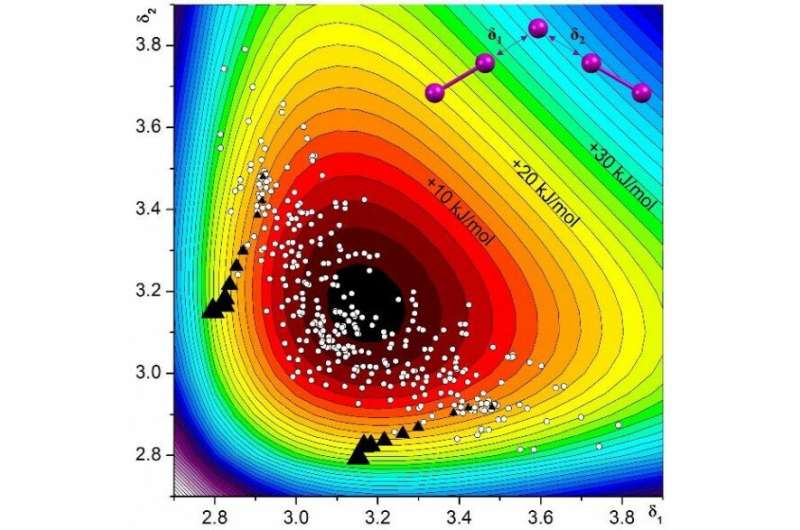Study shows pressure induces unusually high electrical conductivity in polyiodide

A study into the effects of high mechanical pressure on the polyiodide TEAI showed that it brings unusually high electrical conductivity starting from insulating state, suggesting that the material may be useful as a switchable semiconductor. This system could represent an alternative to gel electrolytes and ionic liquids in dye-synthesized solar cells. The paper, "Pressure-induced Polymerization and Electrical Conductivity of a Polyiodide," has been published in Angewandte Chemie.
Polyiodides exhibit useful electrochemical properties such as charge-carrier transportation, high electrolyte energy density, high redox reaction reversibility and a wide range of electrical conductivity, all depending on the forces exerted by the organic counter ions—chemical pressure. For this reason, polyiodides have been used in technical applications in electronic and electrochemical devices such as flow batteries, fuel cells, dye sensitized solar cells and optical devices.
In this study, researchers led by Prof. Piero Macchi at the University of Bern and Dr. Nicola Casati at PSI used powder and single-crystal X-ray diffraction, electrical conductivity, and first principle calculations to investigate the response of one polyiodide, tetraethylammonium di-iodine triiodide (TEAI), to compression achieved by mechanical pressure.
Compared with the chemical pressure, external mechanical pressure affects the crystal inter- and intramolecular landscape more substantially—a huge lattice strain may induce phase transformations and even chemical reactions. Using diamond anvil cells, it is possible to achieve pressure on the order of tens of gigapascals, high enough to significantly change the Gibbs energy, increasing internal energy. Similarly large energy changes are not possible through temperature alteration in solids.
Though complementary, I3 and I2 units are clearly separated and interact mainly electrostatically at ambient pressure .The researchers found that compression stimulates their approach—theoretical calculations show that the covalent contribution increases when the material is compressed. Ultimately, this leads to the formation of CT chains, and drastically increased conductivity.
These features make TEAI a tunable, pressure-sensitive electric switch. Structural studies at high pressure can rationalize the synthesis and search for future organic and hybrid semiconductors based on PI. The study results indicate that solid PI may be used as solid electrolytes in dye-sensitized solar cells, eliminating the need for organic-based gelators and ionic liquids in general.
More information: Tomasz Poreba et al, Pressure-induced Polymerization and Electrical Conductivity of a Polyiodide, Angewandte Chemie International Edition (2019). DOI: 10.1002/anie.201901178
Journal information: Angewandte Chemie , Angewandte Chemie International Edition
Provided by National Centre of Competence in Research (NCCR) MARVEL




















